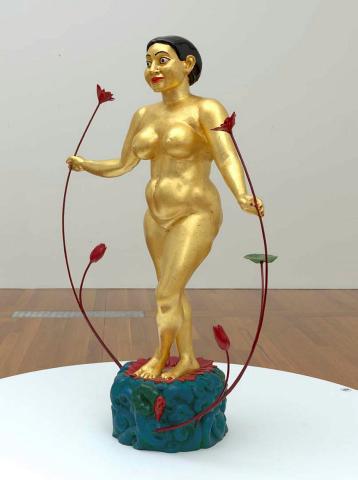REDDY, Ravinder G.; Woman with lotus flower
Ravinder Reddy's works in the early 1990s were burnished terra-cotta busts, generally of women on a modest scale. Reddy's subsequent sculpture evolved to include the entire human form: these works toy with magnification and scale and range from huge female heads measuring up to two metres high, to gilded, life size goddess figures. These large sculptures are made from fibreglass resin, painted and gilded with gold and copper leaf. Reddy begins his creative process by working in clay. He has said: 'I enjoy the physical, tactile participation that clay allows, and the fact that scale somehow just starts growing by itself, enabling one to feel the overpowering presence of form.'(1) Once formed, the clay sculpture is used to make a plaster mould into which the fibreglass resin is poured. These casts are then worked and finished with paint and gold leaf.
The significance of the pre-modern traditions of sculpture, in stone, wood, bronze and terra-cotta, in India and across Buddhist and Hindu Asia, are important when considering Reddy's sculpture. India's rich culture and kitsch form another perspective. The subject of woman, used repeatedly by Reddy, references the early Buddhist sculptures of yakshis (semi-divine female nature spirits) such as those at the Great Stupa in Sanchi c.50-25 BCE, the Mathura sculptures of the second and third centuries CE; Chola sculptures of goddesses from Hindu southern India; as well the central Indian sculpture of Khajuraho. Although these pre-modern traditions provide familiar iconographic models, the contemporaneity of Woman with lotus flower is realised in terms of Reddy's manipulations, translations and simulations of these forms. The direct and unadorned nudity, the highly pitched colour and Reddy's translation of popular cultural iconography combine to form a sculpture that is about the contemporary. Looking at notions of hybridity and fetish, Woman with lotus flower seamlessly touches on how contemporary Indian culture has synthesised its past within the waves of modernisation in a post-colonial India. Reddy himself considers it thus: 'Perhaps it was due to the unprecedented exposure to media, mainly advertising and the cinema, High society was turning ethnic and rural women were taking to nylons and lipstick - I was completely fascinated at the kitsch takeover.'(2)
Reddy's use of the female figure as the primary subject of his sculpture demands another investigation. Considering the political context of India during the 1990s, which has seen an upsurge in primarily Hindu fundamentalist rhetoric which has colonised how deities, and particularly goddesses, are represented, the nude figure in Woman with lotus flower has a range of implications. Lotuses have a long symbolic association with Buddhist and Hindu sculpture. As Buddhist symbol, it is an anionic representation of the Buddha while also being a symbol of enlightenment. The lotus is also part of the complex symbolism of the Bodhisatva Avalokitsvara, who is always represented holding a long stemmed lotus, among other things. Traditional Samadhi Buddha images are also represented seated on a stylised open lotus bloom. In Woman with lotus flower the shining, golden female nude stands on an open lotus and holds two lotus flowers in her hands. The figure itself assumes the traditional tribhanga stance, with one foot crossed over the other, of Hindu bronze sculptures of goddesses such as Parvati. Considered in the contemporary context of India, Woman with lotus flower flirts with a long tradition of the representation of the female nude. Situated within the tension of a fundamentalist positioning that goddesses cannot be represented as nude figures while recalling a pre-modern tradition of nude sculpture, Woman with lotus flower becomes a brave statement of reclamation. Here, a history of Indian sculpture is acknowledged but Woman with lotus flower is also firmly situated within contemporary popular theatre, cinema, advertising and other local visual cultural sources. Indeed, Woman with lotus flower celebrates the eclectic and enormously rich culture that is contemporary India.
1. Kapoor, Kamala. 'Conjuring the world: Ravinder Reddy's sculptural emblems', Art Asia Pacific, no. 21, p.78.
2. Kapoor, Art Asia Pacific, p.78.
